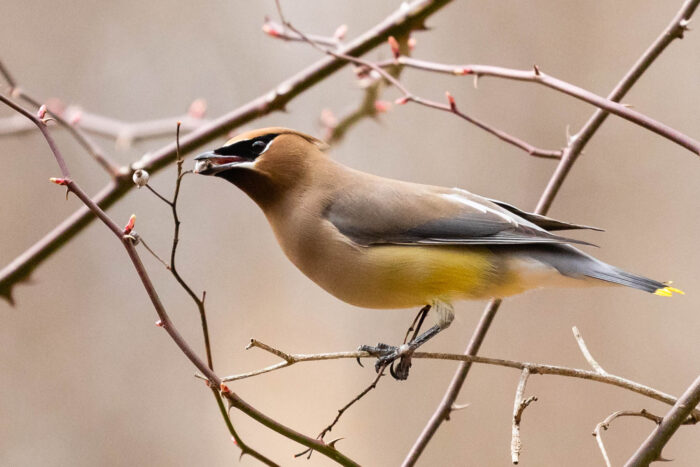Cedar Waxwing
Bombycilla cedrorum
The cedar waxwing is a fruit-loving bird whose wings have a wax-red tip.
This section shows one large critter image at a time. Use the thumbnails that follow to select a specific image to display here.

This gallery contains a grid of small thumbnails. Selecting a thumbnail will change the main image in the preceding section.
Appearance
Cedar waxwings have a silky body that blends from beige to gray to light yellow. They have a black mask on their face. The tips of their wing feathers are wax-red and the tips of their tail feathers are lemon-yellow.
Feeding
Cedar waxwings are a social bird that typically forage in flocks. They will land on a tree or shrub and pluck berries from the branch, or catch insects mid-air. Nearly 90% of their diet is fruit.
Flight
Cedar waxwings move through fields in flocks looking for food. They are very vocal during flight.
Voice
Cedar waxwings primarily make two calls: a high-pitched “Tseee! Tseee!” and a “sighing whistle” according to Cornell’s All About Birds site.
Reproduction and life cycle
Male and female cedar waxwings court by perching near one another on a branch, touching bills and passing food back and forth. They make their nests in late summer and sometimes near other groups of birds. Females lay 3-5 eggs and incubate them themselves, though females and males feed the young. Young leave the nest about 14-18 days after hatching.
Did you know?
Cedar waxwings spread invasive species such as oriental bittersweet and privet by eating their fruit and spreading the seeds.
Cedar waxwings can become intoxicated after eating fermented berries in winter.
The same organic pigment that gives cedar waxwing the wax-red tip on their secondary wing feathers gives red fruits their color.
Sources and additional information
Cedar Waxwing - American Bird Conservancy
Cedar Waxwing - Audubon
Cedar Waxwing - Cornel Lab
